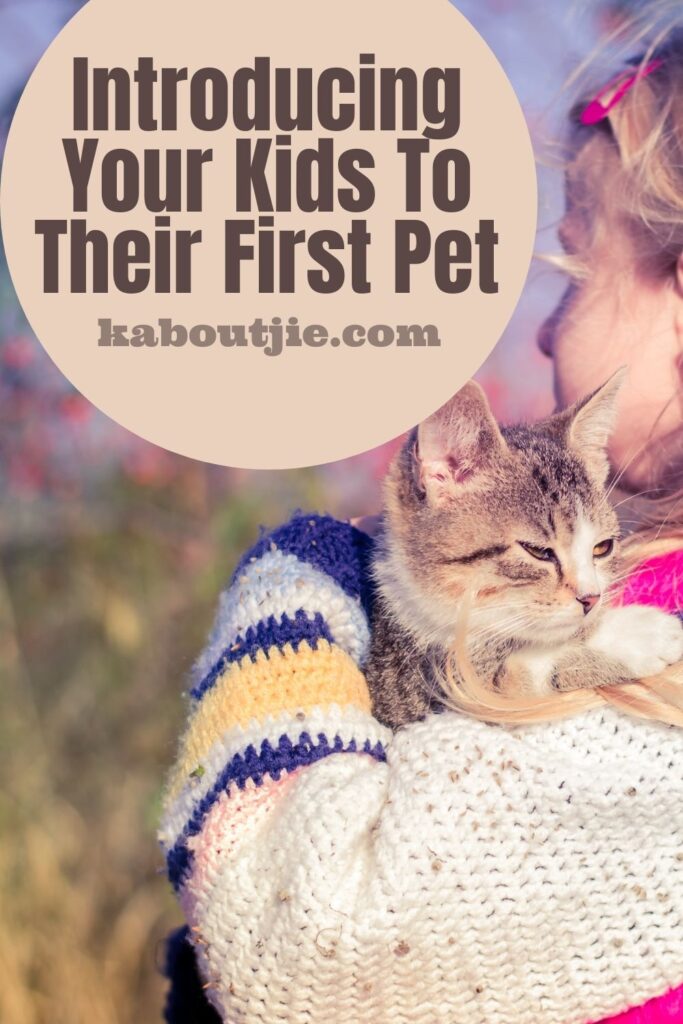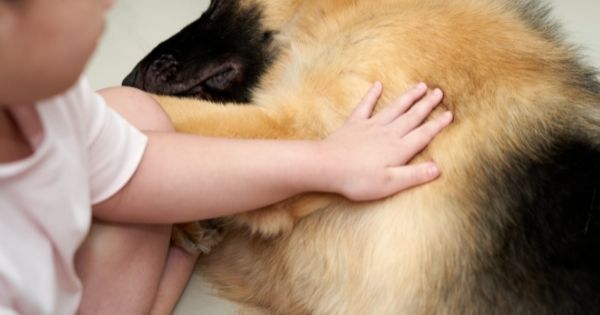When your family is ready to take the leap into pet ownership, it can be easy to wonder how the transition period will be. It doesn’t have to be difficult, but there are some tips to keep in mind.
With kids involved, it’s easy to get caught up in the excitement of owning a new pet. But, having rules in place and focusing on having a healthy relationship with the pet is important. Here’s what to do when introducing your kids to their first pet.

Always Include Adult Supervision
Even the most well intentioned pets have bitten, scratched, or accidently hurt children. This doesn’t mean the pet is bad or wrong. It’s just in their nature to react if they’re scared or hurt. The best thing that you can do for both your kids and your new pet is to supervise the entire time.
It’s best to be nearby and to watch them closely as they interact. Of course, you don’t have to hover, but be close enough to step in if needed. If you notice your kids are playing rough, or if the dog or cat seems apprehensive, calmly separate the kids and pet and resume when everyone has had a chance to calm down.
Let The Pet Do The Approaching
Many dogs, cats, and other animals are usually passive when meeting someone new. So it’s not the best idea to immediately introduce them to your kids and expect them to all get along in just a few short minutes.
Instead, let the pet do the approaching. First, have the kid(s) (one by one if you have multiple children) approach the pet from the side. Then, have them stop when they get a few feet away from the pet. This will allow the pet to decide if they want to approach the kid(s) willingly. This also keeps the animal from feeling overwhelmed.
If your pet decides not to approach your child, don’t force the interaction. Take a few moments, or even a few hours, and try introducing them again. Once the pet has officially approached the child, have your child hold out their hand with their fingers curled to be sniffed. This allows your pet to see that the child isn’t a danger to them.
Avoid Food, Treats, And Toys
When making introductions, don’t include any food products, toys, or treats at first. Some younger pets can get overly excited and may try to fight or steal for their treats. Also, be sure to keep the snacks and food away from your kids as well. If they have a snack in their hands, or are chewing, a pet may take that as a sign to fight for said food.
After introducing your pet the first time, you should be able to incorporate treats and toys. But, your child or children should never directly hand the pet a treat or toy. Instead, have them drop the toy or treats on the ground. Also, you may be able to train your pet to “wait” before picking up the treat or toy.
Stay On The Pet’s Level
Another way to make introducing your kids to their first pet easier is to stay on the pet’s level. This will help the pet feel more at ease, and less on alert. Just like experts recommend dropping to your child’s level when talking or when they’re upset, the same works for pets. It’s less threatening to an animal when their owner is at their level.
Also, remember to avoid touching and petting areas that may be sensitive to the pet, including; their stomach, their tail, their feet, and under their chin. Stick to their back and top of their head, again, depending on the animal.
For example, it may be best to not pet a bigger dog on the head, as that would expose your child’s hand and arm to the dog’s teeth. Of course, you will learn where your pet enjoys being petted, but be cautious at first.

Understand The Pet’s Language
Dogs, cats, and other animals communicate differently than humans. But it’s still possible to understand their communication methods. Depending on the pet you choose for your family, it’s important to understand their language.
For example, dog’s have a language all of their own. Wagging their tail generally means they’re happy. A head tilt will mean that they’re curious about something. And if they tuck their tail and arch their back, they’re usually anxious, or worse, about to bite.
Understanding these languages can help you keep the peace between your new pet and your kids. And, it makes introductions easier, because you’ll be able to decode the language and intervene should you need to.
Keep The Interactions Calm
Children can be aggressive, even when they don’t mean to be. They often don’t understand that they’re being rough, squeezing, or causing harm. And, children can hurt a pet if they aren’t being supervised, which could lead to a pet becoming aggressive and a danger to the safety of the child. To avoid these potential issues, teach your kids to stay calm, and the proper ways to handle a pet.
Of course, avoiding wild movements and loud sounds is essential when you’re first introducing your kids to their first pet. But, you’ll want all of their future interactions to be just as calming as well. Keep in mind that sudden body movements can easily frighten a pet, and can scare them off, or force them to feel like they have to protect themselves.
You can also keep the pet on a leash (if possible) and teach them a few commands like sit and stay before introducing them to your child. This allows you to keep everyone calm, and will help you keep control if something goes awry.
Going Forward, Be As Social As Possible
If you’re getting your new pet as a young puppy or kitten, or young animal in general, give them the freedom and opportunity to be as social as possible.
Take them out on walks, introduce them to new people (by following the steps above), and keep up with positive experiences. By doing this, you’re socializing your pet and showing them that they are in no danger. This will allow them to become more comfortable around people, including the kids, and to continue to feel safe.
As an example, you could all go out on a family walk with your new dog. Or, you can get a cat tree for your kitten and have the kids play with them at least a few minutes every day. And, there are many ways to keep an energetic puppy busy, like playing with toys. The more positive experiences your pet receives with the kids and other people, the better.
Also, don’t be afraid to teach your kids how to handle training either, with your supervision. If you’re teaching your pet commands like sit, stay, roll over, etc., your kids can join in on the training too. If anything, this ensures that your pet listens to everyone in the family equally. And, it can help with bonding between the kids and the pet.
Introducing Your Kids To Their First Pet
Introducing your kids to their first pet doesn’t have to be daunting or scary. In fact, it can be an incredibly positive experience for all parties involved. And, who doesn’t love having a furry or scaly friend to call their own?
 Kaboutjie SA Mommy Blogs by Lynne Huysamen
Kaboutjie SA Mommy Blogs by Lynne Huysamen





Thanx for the tips and advice
My son wants a Pet also
Thank you for this insightful piece, I would however like to find out when is the appropriate age to get her a pet such as a puppy. She’s turning 2 next year January, so would that be an appropriate age?
2 sounds like a great age 🙂
When is the right age? I scared the child won’t be able to hold or want to be friendly.
Helpful indeed. It is wonderful to see a animal and child bond.
My son’s grew up with their puppies. From belly to toddler stage. Inseperable. We now have a 8 month old pittie and she is just the sweetest. Even sleeps with the boys in their beds in the evening. For some families a pet is the missing link